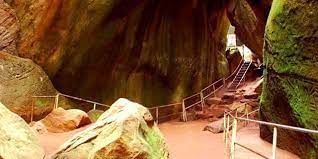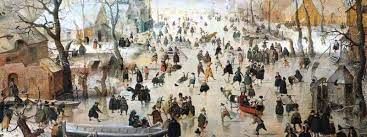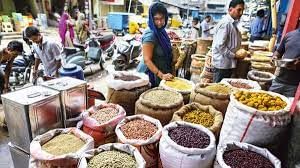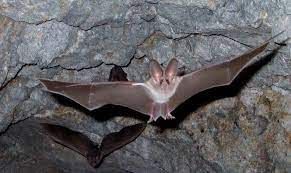UPSC Daily Current Affairs- 23rd October 2023 | Current Affairs & Hindu Analysis: Daily, Weekly & Monthly PDF Download
GS-I
Edakkal Caves
Subject: History

Why in News?
Kerala Tourism has initiated a project aimed at enhancing public facilities in the vicinity of the Edakkal Caves in Wayanad, renowned for its prehistoric rock art.
About Edakkal Caves
- Edakkal Caves are located in the Wayanad district of Kerala on Ambukutty Mala, a significant hill in the area.
- These caves are not your typical caves; rather, they are a natural cleft or rift formed when a part of the rock separated from the main hill.
- Fred Fawcett, a British police official, stumbled upon these caves in 1890 during their discovery.
- Locally, they are also known as "Ampukuthy Mala," with a belief that they were created when Rama's sons, Lava and Kusha, shot arrows into the mountain.
Significance of the caves
- Historical Relevance: The caves hold great historical importance as they are located near an ancient trade route connecting the lofty mountains of Mysore to the ports of the Malabar Coast.
- Ancient Pictorial Inscriptions: Inside the Edakkal Caves, there are pictorial inscriptions thought to date back to at least 6,000 BCE during the Neolithic era.
- Rare Stone Age Engravings: These Stone Age carvings are exceptionally uncommon and constitute the sole known examples from South India, belonging to the Mesolithic era.
- Cultural Significance: The petroglyphs discovered within the caves feature depictions of both human and animal figures, tools used by humans, and mysterious symbols that remain undeciphered, indicating a rich cultural and historical heritage.
- Indus Valley Connection: Some of the paintings within the Edakkal Caves, particularly those portraying a "man with a jar cup," have prompted speculation about a potential link to the Indus Valley civilization.
Source: The Hindu
Little Ice Age (LIA)
Subject: Geography

Why in News?
A recent study unveiled evidence of moist conditions in the Western Ghats, India during the Little Ice Age (LIA).
About the Little Ice Age (LIA):
- One of the coldest periods within the last 10,000 years was marked by pronounced cooling, especially in the North Atlantic region.
- This cold phase, approximately beginning around 600 years ago, triggered crop failures, famines, and pandemics across Europe, resulting in significant suffering and death for countless people.
- The Little Ice Age succeeded the Medieval Warming Period (around 900-1300 CE) and came before the current warming period, which commenced in the late 19th and early 20th centuries.
- Europe and the North Atlantic region bore the brunt of its impact.
- Alpine glaciers surged far beyond their previous and current boundaries, destroying farms, churches, and villages in Switzerland, France, and other areas.
- Frequent harsh winters and cool, wet summers caused crop failures and famines across much of northern and central Europe.
- Furthermore, the North Atlantic cod fisheries declined as ocean temperatures dropped during the 17th century.
Key findings of the study
- Variations in rainfall patterns during the Little Ice Age (LIA) challenged the conventional perception of a uniformly cold and dry climate with reduced monsoon rainfall.
- The study suggested that changes in the climate and increased South West Monsoon could be driven by factors such as the northward movement of the Inter Tropical Convergence Zone (ITCZ), positive temperature anomalies, increased sunspot numbers, and high solar activity.
- The weakest phase of the Indian Summer Monsoon (ISM) during the LIA was attributed to the southward shift of the ITCZ, which resulted from an increased northward energy flux across the equator during a cold northern hemisphere.
- The high-resolution paleoclimatic records generated by this study can be valuable for developing paleoclimatic models to make future climatic predictions and for evidence-based policy planning.
- Understanding the dynamics of climate change and Indian Summer Monsoon (ISM) variability during the Holocene is of great interest to enhance our comprehension of current ISM-influenced climatic conditions and potential future climatic trends and projections.
Source: DTE
GS-II
Visa Shopping in India: Legal Implications and Opportunities
Subject: International Relations

Why in News?
The practice of ‘visa shopping’ is on the rise across various Indian states, most notably in Punjab, where travel agencies facilitate this process.
- Definition:
- 'Visa shopping' refers to the practice of obtaining visas for countries, regardless of whether the individual intends to visit during the visa's validity period.
- Purpose:
- People engage in this practice to ensure entry into their preferred countries, particularly in Europe, even if they already possess visas for other European nations.
- Planning for the Future:
- Some individuals acquire visas for countries they do not plan to visit immediately. This is a strategic move to enhance their chances of obtaining visas for their desired destinations later on. This is crucial due to the often lengthy and uncertain visa application processes.
Exploiting the Schengen System
- Schengen Visa: This visa represents a form of "visa shopping" since it provides a special chance to visit numerous European countries without requiring individual visas.
- Schengen Agreement: Created in 1985, the Schengen system permits unrestricted travel within its 24+ member nations, eliminating border checks.
- Single Visa, Multiple Countries: Acquiring a Schengen Visa from a member country like Germany, France, or Italy allows access to the entire Schengen area.
- Easier Application Process: Many applicants prefer to secure a Schengen Visa from a country with a more straightforward application process.
- Success Stories: Instances include individuals who, after facing rejection for a Spanish or German visa, obtained visas for other Schengen nations, enabling them to reach their intended destinations.
- Compliance with Norms: The practice is legal as long as travellers adhere to visa process norms and obtain legitimate permission to stay in the country.
- Intent Matters: Legal complications arise when individuals seek visas for one country but actually intend to stay in another or use it merely as an entry point.
- Estonian Embassy’s Caution: The Embassy of Estonia in New Delhi cautioned against visa shopping, emphasizing that travellers must apply for a visa from the country where they plan the maximum stay.
- Thorough Scrutiny: Embassies now conduct comprehensive checks of travel plans to detect visa shopping.
- Potential Consequences: Suspected individuals may face visa refusal, being offloaded from flights, or deportation from EU borders.
- Official Suspicion: Repeated engagement in visa shopping can arouse suspicion among immigration officials, leading to potential problems during travel.
Source: The Hindu
Montreux Convention
Subject: International Relations

Why in News?
The Turkish Ministry of National Defence has revealed its intention to enforce limitations regarding the movement of naval vessels from nations that do not share a border with the Black Sea.
About the Montreux Convention:
- Montreux Convention: This international agreement pertains to the Dardanelles and Bosporus Straits, commonly known as the Turkish Straits or the Black Sea straits. It dictates the rules for passage through these straits and is crucial because these are the sole maritime connections between the Black Sea and the Mediterranean Sea.
- Turkish Control: Turkey has authority over the Turkish Straits, as established by the 1936 Montreux Convention. In times of war, Turkey can regulate the transit of naval warships and potentially block access for warships from conflicting nations.
- Freedom of Passage: Merchant vessels have unrestricted access through the Turkish Straits. However, warships are subject to certain limitations, which vary based on whether they belong to the Black Sea coastal states or not.
- Key Provisions: The Convention includes important provisions for the passage of warships, including:
- Aircraft Carriers: Regardless of their origin, aircraft carriers cannot pass through the Turkish Straits.
- Submarines: Only submarines from coastal states can transit the straits for their initial return to the Black Sea after construction or purchase or for repair outside the Black Sea.
- Limitations: There are restrictions on the number and total tonnage of foreign naval forces that can pass through the Turkish Straits, with a maximum aggregate tonnage of 15,000 tons and 9 vessels.
- Non-Coastal States: Non-coastal states are subject to specific restrictions, with a maximum aggregate tonnage of 45,000 tons and a 30,000-ton limit for a single non-coastal state's warships. Their stay in the Black Sea is limited to 21 days.
- Notification Process: Passage through the Turkish Straits must be notified to Turkey via diplomatic channels in advance, with an 8-day notice for coastal state warships and a 15-day notice for non-coastal state warships.
- Article 19: This article of the Convention stipulates that warships from belligerent powers, whether coastal or not, that have become separated from their bases, are allowed to return to their bases through the straits, and Turkey cannot obstruct this process. For example, a Russian fleet stationed in the Black Sea but currently situated in the Mediterranean Sea can use the straits to return to its Black Sea base.
Source: Daily Hunt
GS-III
Making sense of India’s record Food Production
Subject: Economy

Why in News?
Recent data from the agriculture ministry has revealed that India achieved record-high food production in the 2022-23 fiscal year.
- However, this surge in production appears to be at odds with the government’s decision to restrict the export of key staples like wheat and rice, as well as the persistent trend of rising food inflation.
Food Production Statistics
- Record-High Food Production: The agriculture ministry estimates food production for 2022-23 at a historic 329.7 million tonnes, marking a 4.5% increase from the previous year.
- Cereal Production: Major cereal production, including rice and wheat, rose by 4.9% and 2.6%, respectively. Coarse grain production surged by 12%, while pulses production experienced a 4.4% year-on-year decline but remained 6% higher than the five-year average.
- Challenges Faced: These estimations were made despite adverse conditions such as subpar monsoons affecting rice output and late rains causing damage during crop harvesting.
Inconsistencies in the Data
- Export Curbs: In September 2022, India imposed export curbs on broken rice and imposed a 20% duty on certain varieties due to expected domestic production challenges. These curbs have since intensified.
- Wheat Export Ban: Last year, a miscalculation of wheat harvest, primarily due to a heatwave, led to export bans in May 2022, despite promises to bridge global supply gaps after Russia’s invasion of Ukraine.
- Rising Food Prices: Despite record production and export restrictions, retail prices for cereals have continued to surge. Wheat and rice prices have been in double digits, with consumer cereal prices up by 11% year-on-year, and pulses registering a 16.4% increase. As of October 21, retail prices for rice and wheat flour were 12.7% and 5% higher year-on-year, respectively.
Prospects for 2023-24
- Kharif Production Estimate: The first advance estimate for kharif production, typically released in September, is yet to be published. This year’s monsoon, with the lowest rainfall in five years and uneven distribution, is expected to impact rice production, the main kharif crop.
- Pulses and Oilseeds: Additionally, reduced rainfall in several states may affect pulses and oilseeds production. Retail prices for specific pulse varieties like tur (pigeon peas) have already surged by 38% compared to the previous year.
Challenges in Robust Crop Estimations
- Reliability of Data: National crop yield estimates rely on crop-cutting experiments conducted by state revenue and agriculture departments, raising concerns about the accuracy of data collection, particularly in understaffed state departments.
- Remote Sensing: India is using remote sensing to cross-verify the data, yet reliability remains a challenge, especially for crops with multiple harvests.
- Horticulture Crops: Estimating yield for horticulture crops, which are harvested in stages, is even more complex than for food grains.
Conclusion
- India’s agricultural landscape presents a perplexing scenario with record-high food production, export restrictions, and stubborn food inflation.
- The government’s efforts to stabilize prices through export curbs have not yielded the expected results.
- As India navigates the complexities of its agricultural sector, it must address the discrepancies in data collection and explore innovative approaches to ensure accurate estimates and sustainable food security.
Source: The Hindu
Bannerghatta National Park
Subject: Environment and Ecology

Why in News?
The Supreme Court-appointed Central Empowered Committee (CEC) recently directed the office of the chief secretary of Karnataka to submit a response on the issue of encroachment of the eco-sensitive zone (ESZ) of Bannerghatta National Park.
About Bannerghatta National Park:
- Location: It is located near Bangalore, Karnataka, in the hills of the Anekal range.
- Founded in 1971, the park was given the status of a national park in 1974.
- In 2002, a portion of the park became a biological reserve, the Bannerghatta Biological Park. It is the first biological park in India to have a fenced, forested elephant sanctuary.
- In 2006, India's first butterfly enclosure was inaugurated at the park.
- River: Suvarnamukhi stream, the main source of water for the animals of the park, runs through the centre of the park.
- It also acts as an important corridor for the elephants migrating from the Eastern Ghats to the Western Ghats
- Vegetation: There are three types of vegetation that can be found: Dry Deciduous Scrub Forests, Southern Tropical Dry Deciduous Forests and Southern Tropical Moist Mixed Forests.
- Flora: Include Narcissus latifolia, Schleichera oleosa, Sandalwood, Neem, Tamarind, Bamboo, Eucalyptus etc.
- Fauna: Prime habitat for several species, including the endangered Asian Elephant, Indian gaur, Tiger, Sambar deer, Spotted deer, Leopard, Wild dog, Wild pig, Sloth bear, Common mongoose, Pangolin, Slender loris, Black-naped hare, etc.
Source: Indian Express
Bats: Extraordinary Creatures and Genomic Secrets
Subject: Environment

Why in News?
Bats, by many measures, are truly remarkable organisms.
- Their lives are notably extended, and they enjoy a unique defense against a range of diseases, including cancer.
- Significant Population: Bats constitute a substantial part of the mammal world, making up 20% of all mammal species globally. The planet is home to over 1,400 bat species, each exhibiting its own unique characteristics.
- Diverse Characteristics: Bats exhibit a wide range of sizes, from the tiny 2-gram bumblebee bat to the formidable flying foxes, boasting a 1.5-meter wingspan and weighing up to 1.6 kg.
- Ecological Importance: Bats play pivotal roles in maintaining ecological balance by contributing to essential processes such as pollination and insect population control.
- Notorious Reputation: Bats have come under scrutiny primarily due to their role as hosts for various deadly viruses, including coronaviruses, Nipah, Ebola, Marburg virus, and Hendra virus.
- COVID-19 Spotlight: The COVID-19 pandemic has thrust bats into the spotlight, raising concerns about their potential impact on human health.
- Natural Pathogen Hosts: Bats are unique in their ability to harbour numerous pathogens without falling victim to infections, sparking scientific interest in understanding the source of their resistance.
- Genomic Exploration: Scientists have embarked on comprehensive studies of bat genomes, revealing invaluable insights into their distinctive biology.
- Compact Genomes: Bats boast relatively small genomes, typically consisting of around 2 billion bases, making them ideal subjects for genomic research.
- Metagenomic Sequencing: The ambitious Bat1K global genome consortium is currently undertaking the task of sequencing genomes of all bat species worldwide, promising further revelations about their genetic makeup.
- Crucial Immune Genes: The immune-related genes of bats have been a major focus of research, with these creatures exhibiting unique genomic features.
- Reduced Immune Genes: Bats possess a smaller percentage of immune-related genes, approximately 2.7-3.5% compared to humans, who have around 7%.
- Positive Selection: Certain immune genes in bats have undergone positive selection, equipping them to control the spread of viruses while mitigating the inflammatory responses that often prove detrimental to humans.
- Sequencing Advancements: Long-read sequencing technologies have revolutionized our ability to assemble complete genomes quickly and accurately.
- Immune Response Alterations: Recent research employing long-read technology has revealed significant changes in genes responsible for immune responses in bats.
- Interferon Dynamics: There has been a shift in the relative proportions of interferon-alpha (IFN-α) and interferon-omega (IFN-ω) in bats, impacting their immune properties.
- Tumor Suppression and Longevity: Genes linked to tumor suppression and DNA repair in bats exhibit signs of positive selection, contributing to their extended lifespans and reduced cancer risk.
- Emerging Zoonotic Threats: The ongoing processes of deforestation, ecological degradation, and heightened human-animal interactions are anticipated to result in more frequent zoonotic disease outbreaks.
- Genomic Tools: Advanced genome sequencing techniques hold the promise of aiding in the management of these outbreaks while preserving ecological balance, providing insights without disrupting the delicate equilibrium of nature.
Source: The Hindu
|
52 videos|5374 docs|1136 tests
|
FAQs on UPSC Daily Current Affairs- 23rd October 2023 - Current Affairs & Hindu Analysis: Daily, Weekly & Monthly
| 1. What is the significance of Edakkal Caves? |  |
| 2. What caused the Little Ice Age (LIA)? |  |
| 3. What are the legal implications of visa shopping in India? |  |
| 4. What is the Montreux Convention? |  |
| 5. How has India achieved record food production? |  |
















